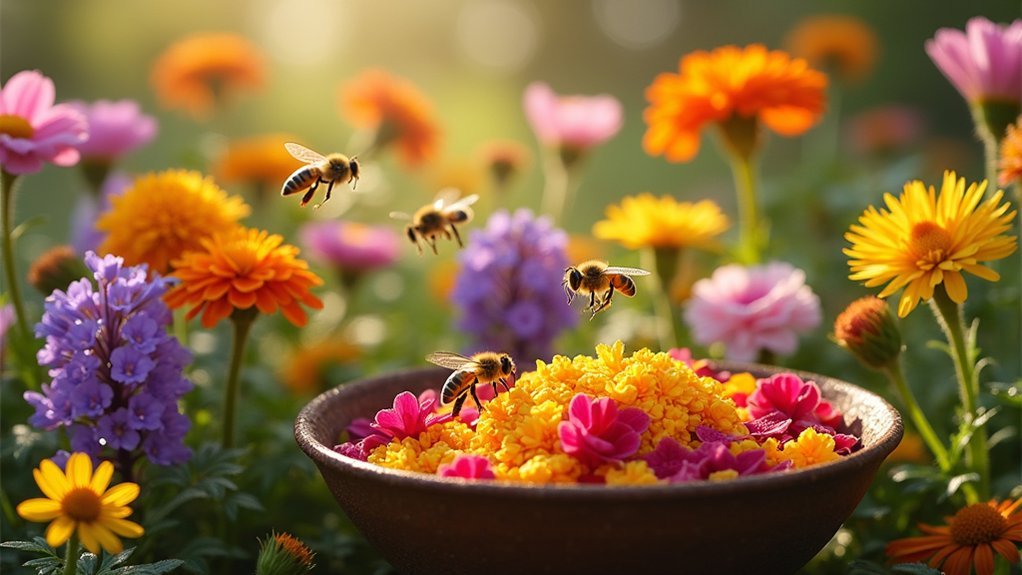Planting edible flowers creates a win-win situation for your garden. You'll attract essential pollinators like bees and butterflies, boosting biodiversity and increasing your overall harvest. Meanwhile, you'll enjoy fresh, flavorful ingredients for culinary use—from borage and nasturtium to calendula and chives. These dual-purpose plants make efficient use of garden space while supporting ecosystem health. Discover how these colorful blooms can transform both your garden ecosystem and your dinner plate.
Dual Benefits: Pollinator Support and Edible Harvests

When you plant edible flowers in your garden, you're creating a win-win environment for both nature and your kitchen. These flowering plants serve as crucial nectar sources for beneficial insects while providing you with fresh, flavorful ingredients.
By incorporating varieties like borage, nasturtium, and calendula into your vegetable garden, you'll attract bees, ladybugs, and other pollinators essential for biodiversity. Your garden becomes a sustainable ecosystem where these creatures thrive, increasing pollination rates and boosting your overall harvest.
The beauty of a dual-purpose garden lies in its efficiency – the same plants supporting pollinator health also enhance your meals. Squash blossoms attract specialized bees while offering delicious cooking options.
You'll enjoy the culinary benefits of fresh, nutritious blooms while contributing to a healthier environment in your backyard.
Top Edible Flowers That Attract Essential Pollinators
Although many gardeners focus solely on vegetables, incorporating edible flowers creates a powerhouse combination for both pollinators and your plate.
Expand beyond pure vegetable growing to embrace edible flowers—your garden and taste buds will thank you.
These plants attract beneficial insects while providing culinary opportunities throughout growing seasons.
When planning your garden, prioritize these pollinator favorites:
- Borage and calendula – Both produce abundant nectar for bees while offering edible flowers with unique flavors (cucumber-like from borage, saffron-substitute from calendula)
- Nasturtiums – Their peppery flowers and leaves add zest to salads while deterring pests from nearby crops
- Chives and sweet violets – These native plants support early-season pollinators and provide delicate blooms for garnishes and confections
Creating Habitat Corridors in Urban Foraging Spaces

Urban foraging spaces offer more than just scattered edible plants—they represent an opportunity to weave living threads through our concrete landscapes.
By designing habitat corridors throughout these spaces, you'll create essential pathways for pollinators to navigate fragmented urban environments.
Strategic companion planting of diverse edible flowers provides a continuous source of nectar for pollinators while enhancing your own harvest potential.
These corridors don't just attract beneficial insects—they support entire ecosystems. Native plants alongside your edible varieties will greatly boost biodiversity and improve pollination rates.
Your urban foraging space can simultaneously address food security and ecological restoration.
When you connect green spaces with thoughtful corridors, you'll witness more bees, butterflies, and birds visiting your garden.
This increased pollinator activity translates directly to greater bounty come harvest-time, benefiting both wildlife and your dinner table.
Year-Round Blooming Strategies for Continuous Nectar Supply
Establishing a perpetual buffet for pollinators requires thoughtful planning of your edible flower garden throughout all seasons. By layering early spring bloomers like chives and pansies with summer favorites such as borage and nasturtium, you'll create a continuous nectar supply for essential pollinators.
To maximize your diverse garden's year-round blooming potential:
- Combine native flowers with traditional herbs to enhance resilience and extend flowering periods.
- Practice regular deadheading of your edible flowers to encourage new blooms and prolong nectar availability.
- Include late-season performers like calendula and rosemary to support pollinators when other food sources diminish.
This strategic approach guarantees your herb garden remains a vibrant sanctuary for beneficial insects while providing you with delicious, beautiful edible flowers throughout the growing season.
Designing Multi-Functional Pollinator Patches for Small Spaces

Even the tiniest balcony or windowsill can become a buzzing haven for pollinators with strategic planning and thoughtful plant selection. Choose compact, edible flowers native to North America like calendula and nasturtium to attract a variety of bees and butterflies while requiring minimal space.
Transform your limited outdoor space into a miniature ecosystem where pollinators thrive through intentional gardening choices.
Embrace vertical gardening techniques using trellises or wall planters for climbing varieties like sweet peas, which provide important habitat in partial shade areas.
Layer your pollinator patches by combining low-growing flowers with taller ones to increase complexity and support a host of pollinators.
Don't forget flowering herbs such as chives and basil, which offer dual culinary benefits while supporting pollinator populations.
Frequently Asked Questions
Why Is It Important to Plant Flowers for Bees?
Planting flowers for bees is essential because you're supporting pollinators that guarantee one-third of our food supply. When you create bee habitats, you're combating their decline while enhancing biodiversity and improving crop yields in your garden.
Why Aren't All Flowers Edible?
You can't eat all flowers because many contain toxic compounds like cyanogenic glycosides that'll harm you. Others have pesticide treatments, unresearched safety profiles, or varying chemical compositions due to genetic differences between related species.
What Is the Symbiotic Relationship Between Bees and Flowers?
You'll find bees and flowers form a perfect partnership: bees collect nectar and pollen for food, while flowers get pollinated. This mutual exchange guarantees both species thrive and reproduce successfully.
What Edible Plants Are Pollinators?
You'll find several pollinators that are edible plants: borage with its cucumber flavor, peppery nasturtiums, mild onion-flavored chive flowers, vibrant calendula with multiple culinary uses, and dill flowers that provide both seeds and attraction.
In Summary
You're creating a win-win ecosystem when you plant edible flowers. By selecting species that nourish both bees and humans, you've turned your garden into a vibrant sanctuary that serves multiple purposes. Whether you're adding color to summer salads or providing critical habitat in urban deserts, these dual-purpose blooms maximize your growing space. Keep experimenting with succession planting—your pollinator friends and dinner guests will thank you.





Leave a Reply